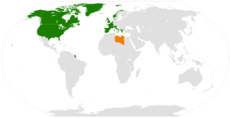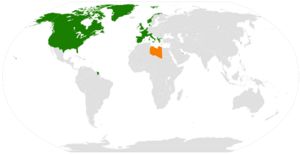United Nations Security Council Resolution 1973 facts for kids
Quick facts for kids UN Security CouncilResolution 1973 |
||
|---|---|---|

States enforcing no-fly zone Libya
|
||
| Date | 17 March 2011 | |
| Meeting no. | 6,498 | |
| Code | S/RES/1973 (Document) | |
| Subject | Libyan Civil War | |
|
Voting summary
|
|
|
| Result | Adopted | |
| Security Council composition | ||
|
Permanent members
|
||
|
Non-permanent members
|
||
|
||
Resolution 1973 was an important decision made by the United Nations Security Council on March 17, 2011. This resolution was about the conflict happening in Libya at the time. It gave permission for countries around the world to take action to protect people in Libya.
The resolution asked for an immediate stop to all fighting. It also allowed for a "no-fly zone" over Libya, meaning no military planes could fly there. It said that countries could use all necessary steps, except sending ground troops, to keep civilians safe. This resolution was proposed by France, Lebanon, and the United Kingdom. Ten countries voted yes, and five countries chose not to vote (they abstained). No countries voted against it.
Contents
What did Resolution 1973 say?
This resolution was created under Chapter VII of the United Nations Charter, which means it allowed for serious actions, including military ones, to keep peace.
Key things the resolution asked for
- It demanded an immediate stop to all violence and attacks against people.
- It created a special area over Libya where no military planes could fly, called a no-fly zone.
- It allowed for "all necessary measures" to protect people and cities in Libya, especially Benghazi. However, it clearly said no foreign armies could occupy any part of Libya.
- It made an existing arms embargo stronger. This meant it was harder for weapons to get into Libya. It also focused on stopping mercenaries (soldiers who fight for money) from entering.
- It banned all flights to and from Libya that were linked to the Libyan government.
- It froze money and other valuable things owned by the Libyan authorities. The resolution said these assets should be used to help the people of Libya.
- It added more people and groups to a list from an earlier resolution (Resolution 1970). These people and groups were not allowed to travel, and their money was frozen.
- It set up a group of experts to check if the rules of the resolution were being followed.
How countries voted on Resolution 1973
| Voted Yes (10) | Chose Not to Vote (5) | Voted No (0) |
|---|---|---|
* Countries in bold are permanent members of the Security Council.
Some permanent members, like China and Russia, had concerns about the no-fly zone. They wondered how it would work and if using force was the best idea. However, they also noted that the Arab League had asked for action and that the situation in Libya was very serious. Because of these mixed feelings, they chose to abstain (not vote yes or no).
African countries on the Security Council strongly disagreed with the actions of the Libyan government. They supported the resolution.
The day after the vote, Angela Merkel, who was the leader of Germany, said that Germany would not join the military action. But she also said that Germany fully agreed with the goals of the resolution. She explained that their decision to abstain should not be seen as being neutral.
India also chose to abstain. They felt there wasn't enough clear information about what was happening in Libya. They also thought the resolution was too vague about how the rules would be enforced.
Brazil abstained because they saw a problem with using force to stop violence and protect people. They worried that using military force might actually make things worse for the very people they wanted to protect. Brazil's Ambassador, Mrs. Viotti, also pointed out that the popular movements in North Africa were happening naturally from within those countries. She was concerned that military action might change this and have big effects on Libya and other places.
How Resolution 1973 was put into action
Military actions in Libya began on March 19, 2011. French Air Force jets destroyed several vehicles belonging to the Libyan leader, Muammar Gaddafi, that were moving towards the city of Benghazi. Then, submarines from the U.S. and the British fired over 110 Tomahawk cruise missiles at targets across Libya. This greatly weakened Libya's air defense system. This made it easier to enforce the no-fly zone.
At first, a group of 10 countries from Europe and the Middle East took part in the actions. Later, this group grew to 17 countries. On March 31, NATO took over command of the operation. The actions helped stop Gaddafi's forces from taking Benghazi.
Later, on August 24, it was confirmed that special forces from Britain, Italy, France, Jordan, Qatar, and the UAE had been working on the ground in Libya. They increased their operations in Tripoli and other cities. Some people wondered if this went against Resolution 1973, but the resolution did not specifically ban the use of special forces.
See also
- Foreign relations of Libya
- List of United Nations Security Council Resolutions 1901 to 2000 (2009–2011)
- Responsibility to protect
- United Nations Security Council Resolution 678
- United Nations Security Council Resolution 1970
- United Nations Security Council Resolution 2016


